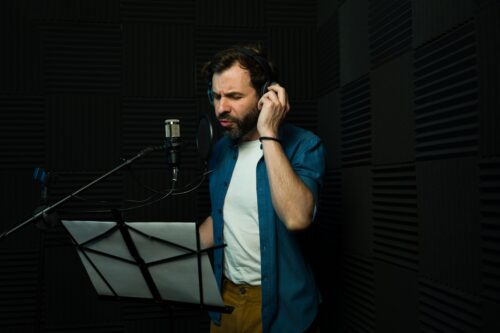From anime and feature films to branded videos and games, dubbing transforms a project’s potential reach. At Voice123, the most trusted network to hire voice actors for dubbing, we understand the importance of voice dubbing in multilingual storytelling.
This detailed guide breaks down what is dubbing, AI dubbing, what is ADR in film, and how to produce dubbed content.
What is dubbing?

Dubbing is the post-production process of replacing the original dialogue in a film, TV show, or video with a new audio track in another language. Voice dubbing aligns with the lip movements, body language, and emotional tone of the original on-screen performance.
Here’s how dubs typically work:
- Script translation into the target language.
- Casting skilled voice actors who reflect the tone of the original actors.
- Recording sessions synced with the footage for precise timing.
- Editing and mixing by sound engineers to ensure perfect sync and quality.
What is voice dubbing?
Voice dubbing focuses on recording voice performances that authentically reflect the character’s intent while matching facial expressions and emotional tone.
The difference between voice dubs and a voice over dub lies in the technique:
- Voice-over dubbing often overlays translated dialogue so you can still hear the original audio playing softly in the background. This technique is commonly used in various types of documentaries.
- Voice dubbing completely replaces the original dialogue with new synchronized lines. This technique is used in films, anime, and video game genres.
Why is dubbed content so popular?
Dubbed content has experienced a surge in popularity as streaming platforms continue to expand globally. Dubs allow audiences to enjoy stories in their own language, without the distraction of subtitles.
Why producers love dubbing
- Wider reach: Access international markets instantly.
- Cultural connection: Adapt humor, idioms, and nuances authentically.
- Enhanced immersion: Keeps audiences focused on visuals and performances.
- Higher ROI: Boosts audience engagement and retention worldwide.
For instance, Squid Game’s 13 dubbed versions are the reason the show had 111 million viewers in just 28 days. That’s not a coincidence, it’s the power of localization done right.
Different types of audiovisual dubbing
Film dubbing
Film dubs capture emotional depth while replacing dialogue. The Star Wars films have been dubbed into over 50 languages, proving their storytelling power.
Video game
Game dubs immerse players in localized worlds. The Witcher 3’s multiple dubbed versions let players experience Geralt’s character authentically in their native language.
Anime
Dubbed anime requires adapting humor and timing. U.S. anime dubs adapt idioms and cultural references to make them sound natural and engaging for Western audiences.
What is ADR?
ADR (Automated Dialogue Replacement) – sometimes called “looping” – is the process of re-recording dialogue during post-production to improve sound quality or change lines.
ADR is not translation-based like a dub. Instead, it refines performances in the same language, ensuring clarity and audio consistency.
What is ADR in film?
ADR in film allows directors to fix poorly recorded dialogue, replace lines altered by script changes, or add new emotional nuance.
For example, if background noise ruined an actor’s on-set audio, the same actor returns to a studio to dub (or “loop”) the line in sync with the visuals.
ADR is essential for:
- Replacing unclear on-set recordings
- Adjusting line delivery
- Syncing with visual edits or new story elements
ADR may not localize language, but it uses the same precision, timing, and emotional alignment that make dubs effective.
How to use dubbing AI

Dubbing AI is transforming how producers and directors handle multilingual projects. With AI dubbing tools and AI voice changers, content can now be localized faster than ever.
Top tools for AI dubbing include:
- Descript – AI-powered editing with automatic video dubbing.
- Papercup – Converts voices naturally from one language to another.
- Synthesia – Generates multilingual avatars with dubbed voices.
- Voiseed – Dubbing AI that mimics real emotional tone in dubbed speech.
- Deepdub – Uses machine learning for natural-sounding localization.
- Respeecher – AI voice changer that recreates iconic voices like Val Kilmer.
How to dub AV content with professional voice actors
Dubs aren’t just about recording—it’s about crafting emotional resonance. For directors and producers, collaborating with professional voice actors ensures the human artistry AI can’t replicate.
Here’s how to dub AV content effectively:
1. Localize the script
Translate your script with cultural accuracy. Adapt humor, idioms, and tone to match your target audience.
2. Cast the right voice actors
Choose voice actors who embody your characters’ emotional range. On Voice123, you can filter by language, accent, gender, and tone to find perfect matches.
3. Sync emotion
Lip-syncing is critical, but emotional syncing seals the authenticity. Skilled actors naturally mirror the original scene’s energy and intensity.
4. Use audio mixing
Sound engineers align timing, level the audio, and integrate ambient sounds—because polished mixing makes or breaks realism.
Hire professional dubbing voice actors on Voice123 to bring your content to life across languages.
Final Thoughts
From ADR in film to AI dubbing innovation, dubbed content continues to evolve. Yet, its purpose remains the same—to connect people through sound, emotion, and language.
If you’re ready to globalize your next project, Voice123 has the professional voice talent to make your story resonate in any language.
Work with Voice123’s voice actors for your multilingual production. Post your project today!
FAQs
It means replacing the original dialogue in a film or video with new audio in another language to make it accessible globally.
It’s the process of translating, recording, and synchronizing dialogue to match the on-screen actors’ performance.
Language dub for translation and ADR dubs for same-language re-recording.
To make stories understandable and emotionally engaging for audiences worldwide, regardless of language barriers.
